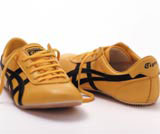Brands treading over new ground

The demand for ‘sports lifestyle’ products is booming, says Trish Lorenz. Research by Dave Campbell
Have a look at your feet right now and there’s a good chance you’re looking at a pair of trainers. From grandparents to toddlers, from boardrooms to bars, they are part of life and many people’s footwear of choice.
For most of us today trainers no longer have the fitness connotations that spawned them and our old skool Vans or cutting edge Nike’s are more likely to see action on a dance floor than a running track. But this is a relatively recent phenomenon. As little as 15 years ago trainers were the domain of the hardened athlete or relegated to the school shoes market.
What does this change mean for trainer brands? Should they still communicate values focused on sporting credentials? How do you balance the dichotomy between fashion and fitness? And what does this mean for designers working to deliver a retail experience for these brands?
Puma, which in the past languished a distant length behind brand leaders Nike and Adidas, has gained ground recently. Since the appointment of chief executive Jochen Zeitz in 1993, the company has gone from being the brand that always got picked last for sports to a potential captain of the sportswear industry.
Profits have doubled over the past year, and Puma brand manager Adam Petrick believes the renaissance is in part due to the fact that Puma is ahead of the curve in current trends for retro shoe styling. What the company calls its ‘sports lifestyle’ market now accounts for 65 per cent of sales.
‘We don’t have an image set in stone, like Nike’s highly competitive sports branding,’ Petrick explains. ‘While we are proud of our sports heritage, we are trying to trade more on our image and on universal concepts, be they funny or clever, that we can hook the product to.’
The company recently announced a GBH-designed revamp of its 18 concept stores across the world (DW 22 May). The refits draw on one of Puma’s central strengths, says Petrick – its identity is flexible enough for people to ‘make of it what they want’.
And, according to Judge Gill designer Stella Taylor, designers across the sector are beginning to recognise that a homogenised approach to branding doesn’t reflect customers’ needs.
‘What we have seen recently is the rise of niche markets in the footwear industry, which have developed from lifestyle buying and fashion influences rather than practical sportswear,’ she says.
The group put this thinking into practice in its recently completed interiors and branding for JD Sports’ flagship concept Boxx, which will stock brands including Puma and Vans and reflects ‘urban influences and contemporary detailing’ in its design.
But Portland Design managing director Ibrahim Ibrahim says most sports stores are still firmly focused on ‘the physical aspects of sport’.
‘They deliberately pile merchandising high and [employ] brash branding to build their sports credentials,’ he claims.
Sometimes this seems no bad thing. Nike, still a market leader, is staying firmly focused on sport. Its Niketown concept store set the pace for others to follow when it launched in 1990, and Jam chief executive Jamie Anley says Nike is on the right track.
‘Nike knows what it is doing by staying focused on performance sport. It’s a lifestyle brand but by not kowtowing [to lifestyle themes] it gets credibility,’ he says.
But he is keen to point out that this offers brands like Reebok and Puma the opportunity to ‘be more creative and adventurous and open up to the lifestyle arena’.
Jam designed Reebok’s trainer lounge (DW 17 October 2002) and chose to ‘express the brand’s Britishness and quirkiness in different ways, not just through sport’, says Anley. ‘Taking it out of one arena and letting its values come alive [through lifestyle expression] is very powerful,’ he says.
The trainer lounge, which is targeted at buyers and journalists, is ‘a place to hang’ he adds. ‘It doesn’t play that heavily on sport.’
Anley claims the importance of sport to mainstream trainer brands is decreasing and questions the value of on-going investment in sporting-celebrities endorsement.
‘Sport is too generic. [Brands] should focus on designing their own initiatives to bring the brand alive in other ways,’ he maintains.
Blueberry Frog creative director Mark Chalmers says sporting connotations remain important, but must be authentic. The group is working with Japanese brand Asics Onitsuka Tiger, probably best known for its Asics running shoes. The brand is re-issuing limited numbers of an old Tiger trainer this year and Blueberry Frog is creating the campaign for the shoe.
It will target the ‘fashionistas’ that set trends for a wider mass audience, and focus on the shoes’ ‘Japanese heritage’, Chalmers explains. The trainer, which was worn by Bruce Lee, has a strong sporting history, he adds, which validates it with this audience.
‘Research has shown a backlash against US brands, [people] are bored with [mainstream brands] and want something authentic and original, but with a quality sporting heritage,’ Chalmers says.
Ibrahim points to a similar trend in performance sports like mountaineering and skiing, which are giving rise to fashion brands like Salomon trainers. The footwear and clothing is designed on ‘high performance principles’, but consumers are wearing the brands to make a statement of ‘I’m in the know, a savvy shopper’, he says.
Fashion and sports seem inexorably linked and designers will need to show some fancy footwork to stay ahead of fashion trends. But it’s clear that as refits wear out quickly in this market, design groups will always be needed to update a trainer brand’s soul.
-
Post a comment



